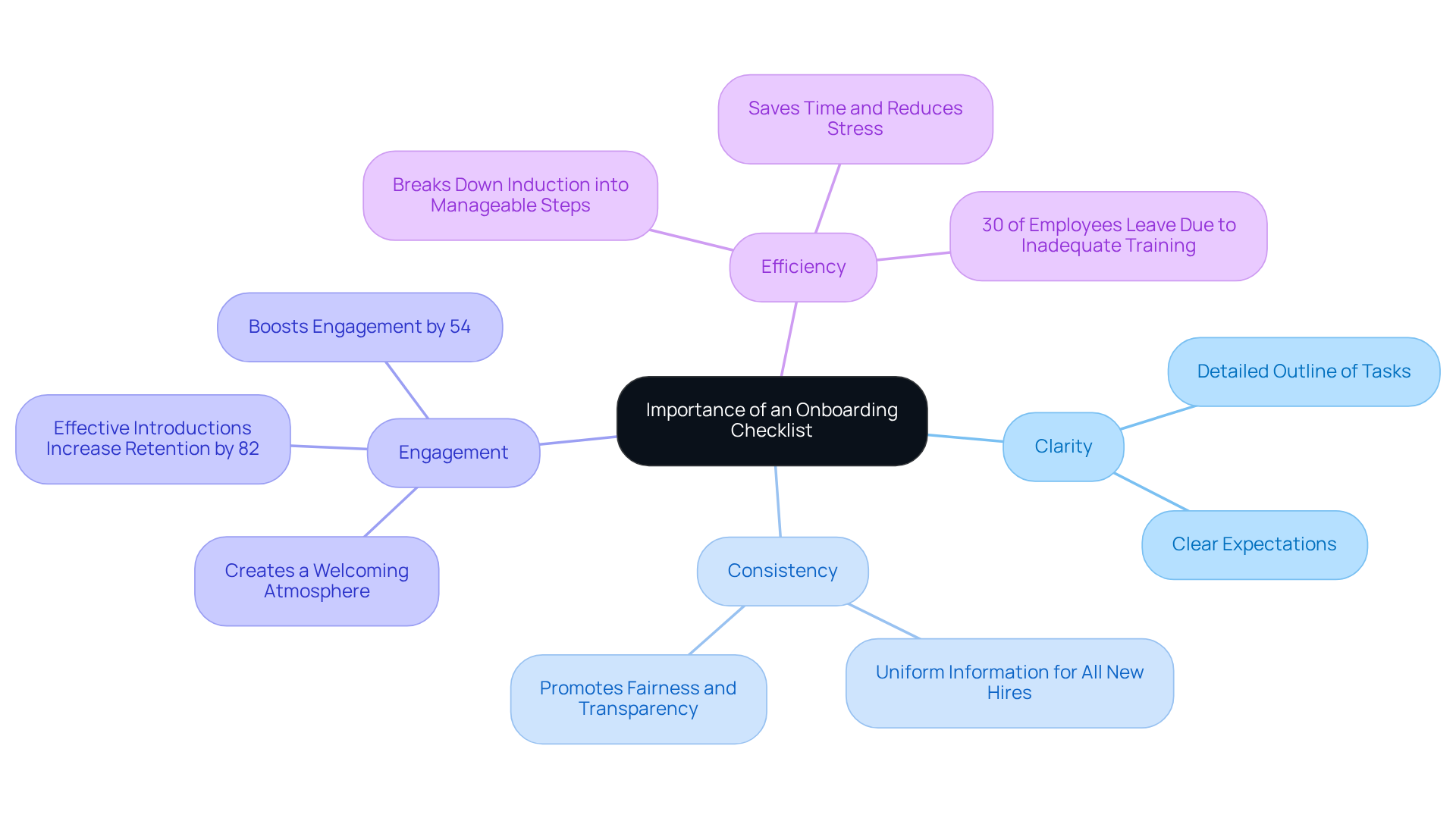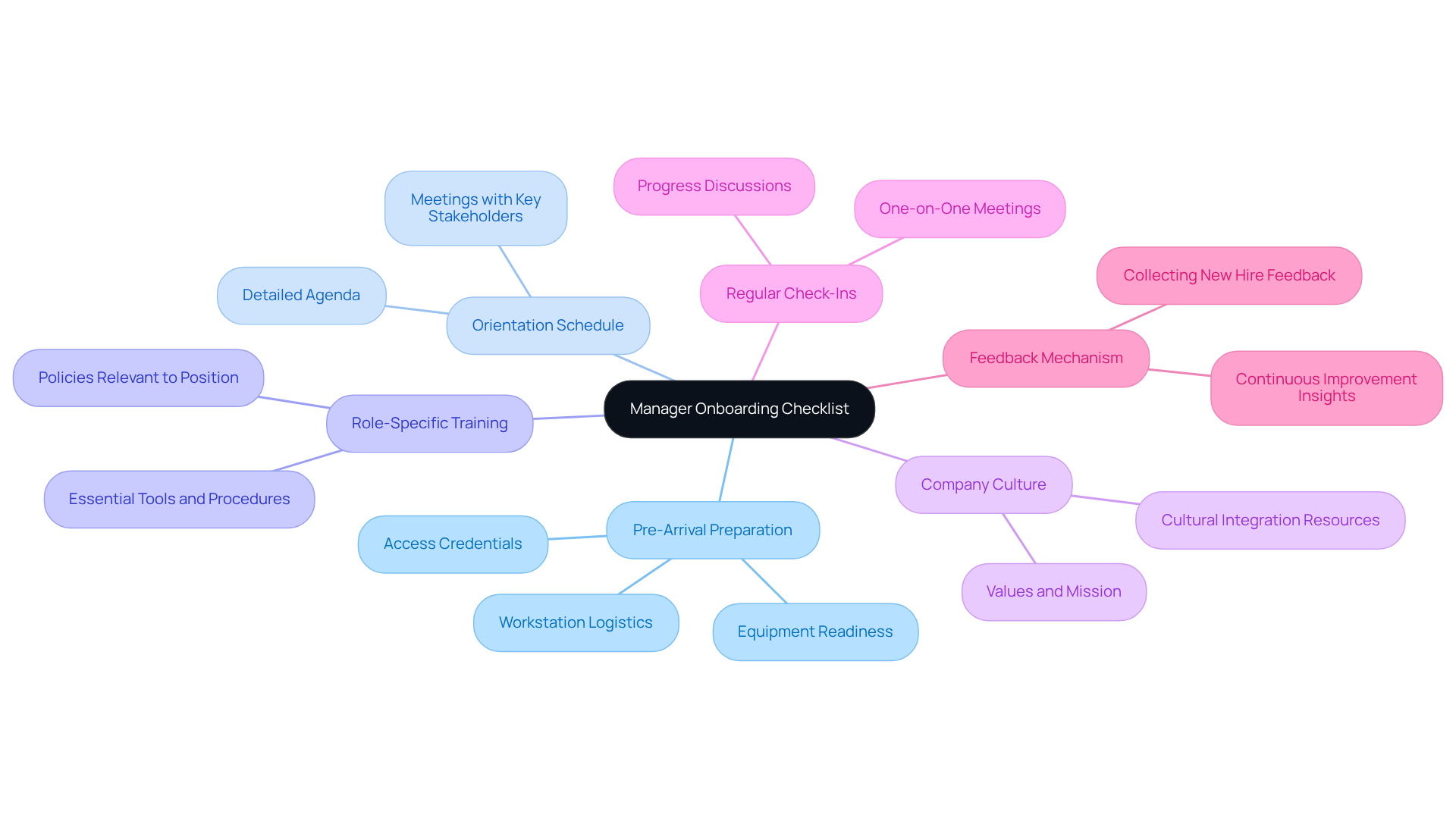
Streamlined Onboarding Processes
|
October 17, 2025
|
5 Steps to Create an Effective Manager Onboarding Checklist
Overview
Creating an effective manager onboarding checklist? It’s super important for helping new managers fit right into their roles, and guess what? This can really boost employee retention rates! You might be wondering what goes into such a checklist. Well, the article highlights some key components like:
- Pre-arrival preparation
- Role-specific training
- Regular check-ins
A structured onboarding process can actually lead to better engagement and productivity, which is a win-win for everyone in the organization!
Key Highlights:
- An onboarding checklist serves as a strategic roadmap, helping new managers integrate smoothly into their roles.
- Effective onboarding can increase employee retention by up to 82%, with positive experiences in the first 90 days significantly boosting retention rates.
- Key benefits of an onboarding checklist include clarity in tasks, consistency in information, enhanced engagement, and improved efficiency.
- Essential components of a manager onboarding checklist include pre-arrival preparation, an orientation schedule, role-specific training, cultural integration, regular cheque-ins, and a feedback mechanism.
- Implementing the checklist involves communicating the plan, assigning responsibilities, scheduling regular cheque-ins, encouraging feedback, monitoring progress, and celebrating milestones.
- Continuous improvement of the onboarding checklist requires collecting feedback, analysing outcomes, updating content, involving stakeholders, documenting changes, and communicating updates.
Introduction
You might be wondering why creating a seamless transition for new managers is so crucial for organizational success. Well, many companies often overlook the power of a structured onboarding checklist. This essential tool not only clarifies expectations and responsibilities but also fosters a sense of belonging that can significantly enhance employee retention.
Speaking of which, did you know that a staggering 30% of employees leave within their first 90 days due to inadequate training? So, how can organizations effectively implement an onboarding checklist that truly prepares managers for success and drives long-term engagement? Let’s dive into that!
Understand the Importance of an Onboarding Checklist
A new manager guide acts like a strategic roadmap, giving you the essential tools and information you need to thrive in your role. This organized approach makes the integration process smoother, helping to ensure that no important tasks slip through the cracks while also fostering a sense of belonging among new employees. By clearly outlining expectations and responsibilities, the checklist boosts communication between you and your team, which can lead to higher job satisfaction and better retention rates. Did you know that effective introductions can increase employee retention by up to 82%? Plus, employees who have a positive experience in their first 90 days are ten times more likely to stick around, showing just how crucial this process is for organizational success.
Now, let’s dive into some key benefits of having an onboarding checklist:
- Clarity: It provides a detailed outline of tasks and expectations, so new managers like you know exactly what’s required.
- Consistency: This ensures that every new hire gets the same information and support, promoting fairness and transparency.
- Engagement: From day one, it creates a welcoming atmosphere, making you feel valued and connected to the organization. In fact, effective orientation can boost engagement by 54%!
- Efficiency: It breaks down the induction into manageable steps, saving you time and reducing stress. Remember, 30% of employees leave their jobs within the first 90 days due to inadequate training experiences, which highlights the need for organized methods.
So, what do you think? Ready to embrace a more structured onboarding experience?

Identify Key Components of a Manager Onboarding Checklist
You might be wondering how to create a well-structured manager onboarding checklist that really sets them up for success. Let’s break down some critical components that can make their transition into a new role as smooth as possible:
First off, Pre-Arrival Preparation is key. Imagine this: all the necessary equipment, access credentials, and workspace arrangements are ready before the new manager's first day. Statistics show that 43% of new hires wait more than a week for their workstation logistics and tools to be in place, which can really hinder their productivity right from the start. By using SowFlow's Chrome extension, you can instantly document these preparations, making sure all the necessary resources are organized and available.
Next up is the Orientation Schedule. It’s super helpful to outline a detailed agenda for the first week, including meetings with key team members and stakeholders. This way, new managers can quickly establish connections and get a feel for their team's dynamics.
Then, there’s Role-Specific Training. Incorporating training sessions that cover essential tools, procedures, and policies relevant to the new manager's position is crucial. Effective orientation can actually cut the time to productivity by 50%! Organizations with organized induction systems see a 50% rise in productivity, so this step is definitely worth the effort. Plus, SowFlow makes it easy to create SOPs and training materials on the fly, streamlining the whole training process and boosting knowledge sharing.
Don’t forget about introducing the Company Culture. Providing resources that help the new manager understand the company’s values, mission, and culture is vital. A solid cultural integration during initial training can really enhance employee engagement and retention.
Now, let’s talk about Regular Check-Ins. Scheduling one-on-one meetings to discuss progress, address concerns, and provide feedback during those first few weeks is essential. After all, employees who undergo effective training are 18 times more likely to feel dedicated to their organization. And get this: 89% of employees say that a great initiation experience boosts their engagement at work. So, regular check-ins? Absolutely necessary.
Lastly, it’s important to have a Feedback Mechanism in place. This allows the new manager to share their thoughts on the orientation experience. That feedback can be gold for continuous improvement, ensuring the training process evolves to meet the needs of future hires. Interestingly, 21% of new hires who quit expected more effective training, highlighting the need for these feedback mechanisms.
By weaving these elements together and leveraging SowFlow's documentation features, organizations can develop a comprehensive manager onboarding checklist that not only prepares new managers for their roles but also fosters a positive and efficient work environment.

Draft Your Manager Onboarding Checklist
Is creating an effective manager onboarding checklist necessary? Let’s walk through some essential steps together:
- Gather Input: Have a chat with HR and your current team members to pinpoint those must-have tasks and resources for your list. Engaging with different folks helps ensure you cover all bases.
- Outline the Structure: Organize your list into clear sections based on those key components you’ve identified. This way, it flows logically, making it easier to understand and execute.
- Be Specific: For each item, lay out detailed instructions and expectations. Instead of just saying 'Complete training,' clarify which training modules are needed and when they’re due.
- Use Templates: Tap into existing orientation checklist templates as a starting point. Many organizations offer templates that you can tweak to meet your specific needs, making the process smoother. And hey, consider using SowFlow's free Chrome extension to quickly document your onboarding procedures. This handy tool lets you save your workflows right in your team’s workspace, boosting accuracy and saving you time—plus, it keeps everything standardized across your organization.
- Review and Revise: Once you have a draft, share it with your stakeholders for feedback. This collaborative review is crucial for making necessary tweaks to ensure the guide truly supports new managers.
- Complete and Share: After finalizing the list, share it with the new manager and relevant team members. This ensures everyone’s on the same page with the integration plan, creating a supportive atmosphere from day one.
By introducing a structured manager onboarding checklist, you can significantly enhance the integration experience. It can lead to better retention rates and happier employees. In fact, effective orientation can boost employee retention by up to 82%! Organizations that prioritize smooth integration processes often see a direct link to increased productivity and engagement among their new hires. So, are you ready to revamp your onboarding approach?

Implement the Checklist During the Onboarding Process
To effectively implement the onboarding checklist during the onboarding process, let’s explore some friendly steps together:
- Communicate the Plan: You might be wondering how to start. At the outset, share the manager onboarding checklist with the new manager, clearly explaining its purpose and importance in facilitating their transition. Did you know that 89% of employees say an excellent orientation process helps them feel engaged at work? That really emphasizes the significance of clear communication!
- Assign Responsibilities: Now, let’s talk teamwork. Designate specific team members to assist the new manager with the tasks outlined in the manager onboarding checklist. This collaborative approach can really help ease the challenges of integration, especially since 42% of HR professionals report difficulties due to scattered information.
- Schedule Regular Check-Ins: Speaking of support, utilizing scheduled meetings to review progress on the tasks is key. This is a great way to address any challenges and provide necessary support, reinforcing the importance of ongoing communication. Frequent check-ins can help reduce the 30% of employees who leave their positions within the first 90 days due to inadequate training experiences.
- Encourage Feedback: Let’s create a welcoming atmosphere! Encourage the new manager to feel at ease providing input on both the integration experience and the manager onboarding checklist. This feedback is crucial for enhancing ongoing development, as workers with excellent integration experiences are 30 times more likely to feel overall job satisfaction.
- Monitor Progress: Keep an eye on how the new manager is fulfilling task items. It’s important to modify the manager onboarding checklist as necessary to ensure all essential areas are effectively covered. Organizations with effective integration processes can boost employee retention by as much as 82%, so careful oversight is a must!
- Celebrate Milestones: Lastly, let’s not forget to celebrate! Acknowledge the achievement of important tasks in the manager onboarding checklist to inspire the new manager and enhance their sense of belonging within the team. Celebrating milestones can really boost engagement; 89% of employees feel more dedicated to their employer when they undergo effective orientation.

Review and Update the Checklist for Continuous Improvement
To keep your onboarding checklist effective, let’s chat about some steps for continuous improvement:
You might be wondering how to start. First up, Collect Feedback! After each induction cycle, gather insights from new managers about their experiences with the manager onboarding checklist and their overall integration. This feedback is crucial—did you know that employees who have a positive orientation experience are 10 times more likely to stick around?
Next, let’s Analyze Outcomes. Take a look at retention rates, performance metrics, and the overall satisfaction of new hires. This will help you identify areas that could use a little TLC. Organizations that have organized induction processes can see retention rates improve by up to 82%! Pretty impressive, right?
Now, it’s time to Update Content. Revise the manager onboarding checklist according to the feedback and analysis you’ve collected. Make sure to include any new tasks, resources, or training that might have slipped through the cracks. Continuous adaptation is key, especially since a whopping 37.4% of HR professionals say remote integration is a big challenge.
Don’t forget to Involve Stakeholders! Get HR and team leaders in on the evaluation process to ensure the checklist aligns with your organization’s goals and best practices. Collaborating can lead to a more comprehensive introduction experience. In fact, 58% of firms admit they focus too much on procedures and documentation, which can limit training opportunities.
Next, make sure to Document Changes. Keep a record of any updates made to the checklist for future reference. This documentation is vital for maintaining consistency and accountability in your integration process.
Finally, let’s talk about Communicate Updates. It’s essential to inform everyone involved about any changes to the checklist. This way, everyone is on the same page with the most current version. Effective communication fosters a culture of transparency and continuous improvement—both of which are crucial for enhancing the onboarding experience.

Conclusion
Creating an effective manager onboarding checklist isn’t just a box to tick off; it’s a crucial strategy that really boosts the integration experience for new managers. By taking a structured approach, organizations can make sure that new leaders have all the tools, knowledge, and support they need to succeed in their roles. This systematic onboarding process brings clarity, consistency, and engagement, which can lead to higher retention rates and overall job satisfaction.
You might be wondering what this looks like in practice. Well, throughout the article, we’ve highlighted several key components, like:
- Pre-arrival preparations
- A detailed orientation schedule
- Role-specific training
- Cultural integration
- Regular check-ins
- A solid feedback mechanism
Each of these elements is essential in making sure that new managers feel supported and connected right from day one. And here’s a fun fact: organizations with structured induction processes can see retention rates soar by up to 82%!
So, what does this mean for your organization? It’s time to prioritize the development and continuous improvement of your onboarding checklists. By actively seeking feedback, analyzing outcomes, and making necessary updates, you can create a dynamic onboarding experience that adapts to the changing needs of your workforce. Investing in a comprehensive onboarding strategy not only boosts employee satisfaction but also drives long-term organizational success. Embrace the power of effective onboarding and transform how new managers are welcomed into your team!
Frequently Asked Questions
Why is an onboarding checklist important for new managers?
An onboarding checklist acts as a strategic roadmap, providing essential tools and information that help new managers thrive in their roles. It ensures that important tasks are not overlooked, fosters a sense of belonging, boosts communication, and can lead to higher job satisfaction and better retention rates.
What are the key benefits of having an onboarding checklist?
Key benefits include clarity in tasks and expectations, consistency in the information provided to new hires, enhanced engagement from day one, and increased efficiency by breaking down the induction process into manageable steps.
How does effective onboarding impact employee retention?
Effective introductions can increase employee retention by up to 82%, and employees who have a positive experience in their first 90 days are ten times more likely to remain with the organization.
What components should be included in a manager onboarding checklist?
Key components include Pre-Arrival Preparation, an Orientation Schedule, Role-Specific Training, introduction to Company Culture, Regular Check-Ins, and a Feedback Mechanism.
What is the significance of Pre-Arrival Preparation?
Pre-Arrival Preparation ensures that all necessary equipment, access credentials, and workspace arrangements are ready before the new manager's first day, which is crucial for productivity.
Why is an Orientation Schedule important?
An Orientation Schedule outlines a detailed agenda for the first week, helping new managers establish connections with key team members and understand team dynamics.
How does Role-Specific Training benefit new managers?
Role-Specific Training covers essential tools, procedures, and policies relevant to the new manager's position, significantly reducing the time to productivity and enhancing overall efficiency.
What role does company culture play in onboarding?
Introducing company culture helps new managers understand the organization’s values, mission, and culture, which is vital for enhancing employee engagement and retention.
Why are Regular Check-Ins necessary during onboarding?
Regular Check-Ins allow for one-on-one meetings to discuss progress, address concerns, and provide feedback, which is essential for ensuring that new employees feel dedicated to their organization.
What is the purpose of a Feedback Mechanism in the onboarding process?
A Feedback Mechanism enables new managers to share their thoughts on the orientation experience, providing valuable insights for continuous improvement of the training process.
👍
What others are liking
5 Steps to outline your ideal documentation structure
5 MINS READ
Where to start the your journey of mapping out your ideal documentation structure, aligning it with the very heartbeat of your organization?
Defining a winning level of detail in your process
3 MINS READ
What is too much detail, and what is too little? This article described in that winning level detail about what detail is enough.





